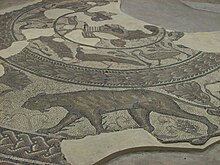Orpheus Group
As the Orpheus Group ( Orpheus Group ; also Corinian Orpheus Grou p) mosaics from the south-west of England are called in research, which have so much in common that they were probably made by the same artists. The mosaics in this group date to the first half of the fourth century.
In an article in 1965 , David J. Smith summarized several groups of British mosaics into schools and assumed that these schools go back to workshops that operated in various cities. His main school was the Corinian School , which probably worked in Corinium Dobunnorum ( Cirencester ).
However, further research has shown that the concept of school is problematic, as research knows very little about how the production of mosaics was organized. Instead, recent research rather prefers the term Group ( group ) to summarize certain mosaics that have certain similarities, while the term school has certain implications in art history, which can not be said whether they apply to these mosaics. The Corinian School in particular put together a number of mosaics that differ considerably in detail, so that it seemed necessary to divide them into two further groups. These are the Orpheus Group and the Saltire Group .
The Orpheus Group also operated in or around Corinium Dobunnorum. Mosaics with an Orpheus as the central motif are particularly typical . The two main mosaics of the group are the Orpheus mosaic from the Roman villa at Woodchester and the Orpheus mosaic from the villa at Barton Farm at the gates of Corinium Dobunnorum. They have so much in common that it was early assumed that they came from the same hand. Orpheus is depicted in a central circle on both mosaics. Birds are shown in a second, outer circle, while various animals appear in a third outer circle. The circles are separated by rich ornamental ribbons. Not only do mosaics with Orpheus as a central motif come from the group, but Bacchus can be found in other villas instead . Other typical features are ornamental bands with the swastika - meander motif, which often show a doubling of the loops. A beige stone is often used as the background color for figurative representations.
Orpheus Group mosaics were found in:
- Chedworth (Villa Rustica)
- Corinium Dobunnorum (Cirencester)
- Spoonley Wood (Villa Rustica)
- Stonesfield (Villa Rustica)
- Woodchester (Villa Rustica)
Individual evidence
- ^ David J. Smith: The Corinian School. In: Albert LF Rivet (Ed.): The Roman Villa in Britain. Routledge & Kegan Paul, London 1969, pp. 97-102.
- ↑ Stephen, Neal: Roman Mosaics of Britain, Volume IV , p. 16
literature
- Stephen R. Cosh, David S. Neal: Roman Mosaics of Britain, Volume IV, Western Britain , The Society of Antiquaries of London, London 2010, ISBN 978-0-85431-294-8 , pp. 16-18.

